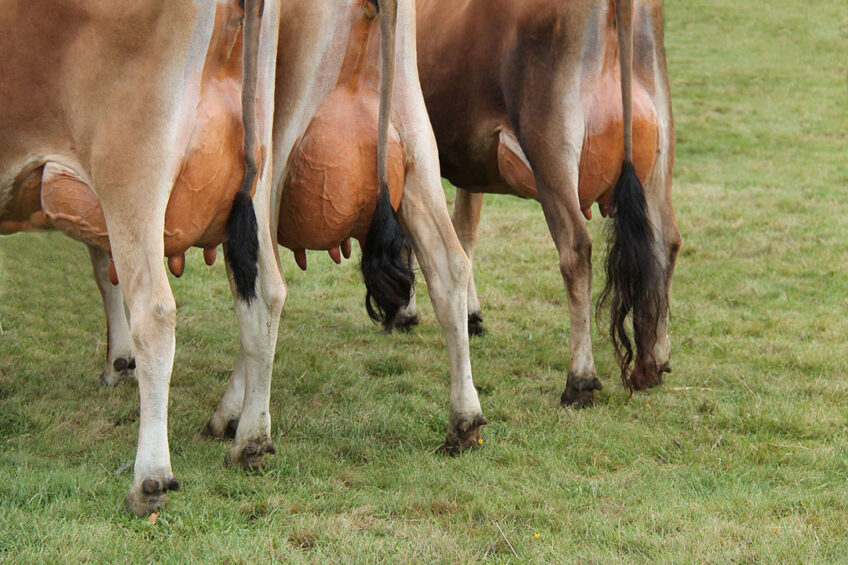How to avoid a broken tail in dairy cows

Broken tails typically do not involve fractures to vertebrae; however, they cause substantial pain and distress in dairy cattle, which must be avoided at all costs.
Low-stress handling during routine management practices is essential for dairy cows’ welfare. Tail manipulation, including lifting and twisting, is one of the common handling methods used to prompt forward cattle movement or to get dairy cows to stand still depending on circumstances. However, improper twisting with excessive force results in dislocation of the intervertebral joints, tears to the caudal fascia, damage to the intervertebral connections, tail deviation, and subsequent swelling.
Dairy cattle tail structure
The dairy cattle’s tail is an extension of the spine, made up of caudal vertebrae separated by cartilage discs, with a series of blood vessels and nerves running underneath the vertebrae. There are about 18-20 vertebrae in a cow’s tail. Cows have about 207 bones in their body, so their tail makes up almost 10% of those bones.
A strong caudal fascia encases the muscles around the caudal vertebrae. Caudal fascia comprises 2 layers, a thin superficial layer attached to the skin, and a thicker deep layer connected to the caudal vertebrae.
What causes broken tails?
Incorrect handling by impatient stock people is known to be the primary cause of broken tails; however, facility design, including incorrectly installed automatic manure scrapers, may contribute to tail breaks on dairy farms, as well.
The magnitude of force required to break a tail is at least 9.8 newton-metre and the maximum torque required to break a tail is 20 newton-metre; thus, it is implausible that sufficient force to break the tail would be accidentally applied by a handler when proper handling techniques are used.
Therefore, the presence of broken tails indicates injuries inflicted by people during handling and can be an abusive act. The prevalence of broken tails ranges from 0-50%; however, the threshold for broken tails should be less than 1%.
Welfare impacts of a broken tail
Broken tails are displayed in various ways: none or small deviation in a tail where there is swelling around the affected joint which may not be immediately visible. In this case, the swelling may resolve completely or may cause small firm chronic swelling. In case of obvious tail deviation at the time of the ‘break’, a firm swelling will develop around the affected area.
Multiple breaks with deviation are caused by a severe injury or multiple injuries. In severe cases, the breaks are accompanied with bony protrusion through the skin and acute pain. The welfare impact of a broken tail is due to the direct impact of the injury, sensitivity to pain, increased likelihood of the cow’s tail being damaged again due to weakness caused by the initial injury, and reduced function of broken deviated tail regarding controlling flies and signalling.
How to decrease the risk of broken tails?
There are several alternative strategies to minimise the risk of broken tails:
- 1 or 2 handlers can push up the rump of the cow with their back or shoulder to encourage her to move forward.
- In addition, changing the environment, minimising loud sounds, shadows, and blocked exits to avoid scaring the cow, using meal or molasses to entice the cow and to create a positive experience.
- Bringing in other settled animals to create a sense of safety are helpful methods to decrease the incidence of broken tails.
- Proper cow restraining using crushes, vet races, and head bales makes stock handling safe and easy.
- Proper use of kick bars prevents kicking and tying the cow’s leg down versus up is more natural to the cow and can reduce stress during restraint.
- Handling heifers prior to calving and introducing them to the shed decreases stress, enhances milk let down, and creates a safer working environment.
- It is recommended to handle tails as a last resort in the natural range of motion that causes no pain or damage to the cow.
- Holding the tail at the base to lift it and avoiding lifting it higher than spine height, grabbing, bending, or twisting the tail are important to consider.
- In case of a damaged tail, draft the cow out, call your veterinarian, record the injury, discuss after care and pain relief with the veterinarian, and the cause to prevent damage to other tails.
Conclusion
A broken tail is an indicator of poor welfare with up to 50% prevalence in dairy farms. However, most on-farm welfare programmes do not include broken tails as an assessment measure. Incorrect handling by impatient stock people is the major cause of broken tails, thus using alternative strategies minimises the risk of broken tails.






